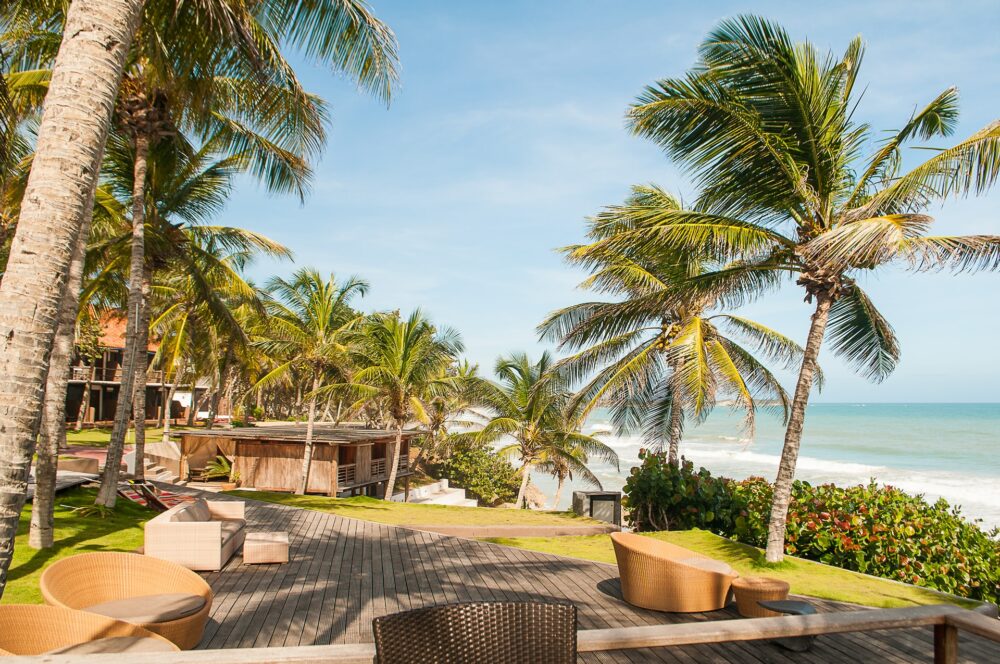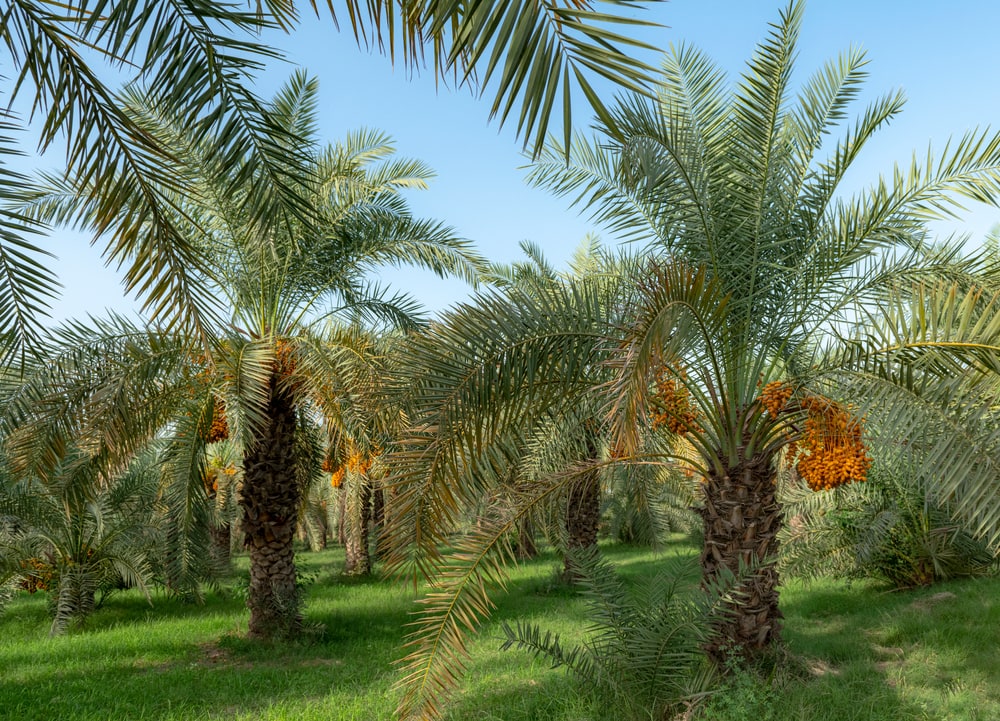11 Types of Palm Trees In California (With Pictures)
-
Elizabeth Gray
- Last updated:

Besides the famous redwoods, the tree most often associated with California is probably the palm tree. But did you know that only one palm species is actually native to the state? However, because the state is such a friendly environment for palms, many non-native species will happily thrive there. Here are 11 types of palm trees that you can grow in California.
The 11 Types of Palm Trees in California
1. Fan Palm

| Scientific name | Washington filiferia |
| Height | 49–66 feet |
Also called the desert fan palm, California fan palm, or California palm, this plant is the only palm tree species native to the state. They occur mainly in deserts, like the Mojave, near water sources. The fan palm requires full sun to grow and prefers well-drained soil. It is an evergreen species that produces white and yellow flowers during winter and spring. These trees are easy to care for, and naturalized populations exist in other locations, including Hawaii, the southeastern United States, Australia, and the U.S. Virgin Islands.
2. Beach Palm

| Scientific name | Allagoptera arenaria |
| Height | 6 feet |
Also called the seashore palm, this species is native to Brazil but thrives in California. In its native land, beach palms grow near the coast and help maintain erosion control. The palms are very adaptable and can tolerate the dry climate of California, though they are technically tropical plants accustomed to humidity. They are a popular ornamental palm because they grow no higher than 6 feet and have beautiful foliage. Beach palms need full sun but tolerate drought reasonably well.
3. King Palm

| Scientific name | Archontophoenix alexandrae |
| Height | 40–60 feet |
Native to Australia, the king palm grows beautifully in Southern California and is one of the most popular species for ornamental use. The palm grows slowly, reaching heights of 40–60 feet, with a multi-colored trunk and dark green fronds. King palms bloom in the summer, producing lovely pink and purple blooms. They require very little maintenance, are drought-tolerant, and grow in full sun to partial shade. However, the fronds may turn brown when exposed to excessive sunlight. King palms also tolerate the salty air near the California coast, making them an excellent choice for beach-side planting.
4. Dwarf Sugar Palm

| Scientific name | Arenga engleri |
| Height | 12 feet |
This palm originates from the Philippines but can grow in California given the right conditions. The natural spreading and clumping tendency of this plant makes it an excellent choice for privacy screening. Dwarf sugar palms require a moderate level of care. They prefer moist soil and are not particularly drought tolerant. For best results, they need regular fertilization and watering during the dry season in California. Dwarf sugar palms can grow in full to partial sun but are not tolerant of salty air.
5. Mexican Fan Palm

| Scientific name | Washingtonia robusta |
| Height | 70–100 feet |
These tall, hardy palms are one of the most popular species for commercial and city landscaping because they are fast-growing and low maintenance. Mexican fan palms are a common site along freeways, beaches, and city streets in California. Once established, this species requires little water: a definite bonus in California’s dry climate. Unlike most palm species, this one doesn’t shed its dead fronds, which will build up over the years. A yearly visit from a tree trimmer keeps the Mexican fan palm looking tidy but isn’t necessary for any reason other than appearances.
6. Queen Palm

| Scientific name | Syagrus romanzoffiana |
| Height | 40–50 feet |
Queen palms are native to South America but also grow well in California. They are quite cold tolerant, which is surprising considering palms are generally thought of as tropical plants. This species is popular for home landscaping because it grows quickly and has long fronds, perfect for providing shade from the hot California sun. The queen palm prefers full sun and well-drained soil. It is fairly drought-tolerant but prefers to be watered once a week. Regular fertilization is also recommended.
7. Date Palm

| Scientific name | Phoenix dactylifera |
| Height | 70 feet |
This is an ancient species grown in the deserts of ancient Egypt, but the date palm is also common in California. The frond canopy of this species can grow as wide as 30 feet, providing both shade and beauty. Date palms produce edible fruit (dates!) and can also be used to make palm wine. Because they are among the most decorative of palms, they are commonly used to add an upscale vibe to home and commercial landscapes. Date palms can grow in full or partial sun. They are drought-tolerant but will look their most regal with constant watering and regular use of fertilizer.
8. Kentia Palm

| Scientific name | Howea forestiana |
| Height | 35–40 feet |
Also called the sentry or paradise palm, this species is native to Australia. Kentia palms are slow-growing with feathery, attractive fronds. They can be grown on their own or planted in groups to form a palm forest. These are adaptable palms that tolerate a range of soil conditions and any lighting condition from full sun to partial shade. They prefer shade for the first few years of growth and like moist soil but dislike too much water. This species can also be grown in containers as an indoor palm.
9. Cuban Royal Palm

| Scientific name | Roystonea regia |
| Height | 60–70 feet tall |
Also called the Florida royal palm or simply the royal palm, this plant is native to Cuba and South Florida. It can grow in California, but only in areas that rarely see freezing temperatures, as it is not a cold-tolerant palm. The Cuban royal palm has a lovely smooth, gray trunk and produces yellow flowers during the summer. It is not picky about soil quality and is fairly drought-tolerant, although it prefers regular watering. Cuban royal palms about a foot per year and don’t mind extreme heat, making them a good fit for desert environment landscaping.
10. Bismarck Palm

| Scientific name | Bismarckia nobilis |
| Height | 40–70 feet |
The Bismarck palm is native to the island of Madagascar and boasts unique, fan-shaped fronds in a blue-green hue. Bismarck palms tolerate hot, dry weather but prefer well-drained soil. Consider testing your soil before planting since this palm will develop discolored, orange leaves if they don’t get enough potassium. They can grow in full sun to partial shade and are also moderately salt tolerant. Although they make quite a statement in a landscape, the Bismarck palm may grow too tall for small yards.
11. Pindo Palm

| Scientific name | Butia capitata |
| Height | 15–20 feet |
Also called the jelly palm, this native Brazilian tree is a slow-growing species that is easy to maintain. It is a smaller palm, not too big for home landscaping. The Pindo palm tolerates heat, wind, and even temperatures below freezing. They grow best in well-drained soil and produce colorful flowers and fruit. The edible fruit serves as a food source for birds and wildlife, another attraction of this palm. However, it will make a mess as it falls, so plant this tree away from sidewalks, driveways, or houses.
Conclusion
Choosing plants that fit your sun, soil, and water parameters is vital when planning your landscaping. Palms can make an eye-catching and shady addition to your yard, but larger ones may grow to an overwhelming size. If you choose to plant palms, ensure they are spaced appropriately from your house or other buildings to avoid any concerns. California offers a unique growing environment, and palms are one of the plants happiest to put down roots in the state.
Featured Image Credit: Bob Osias, Unsplash
Contents
